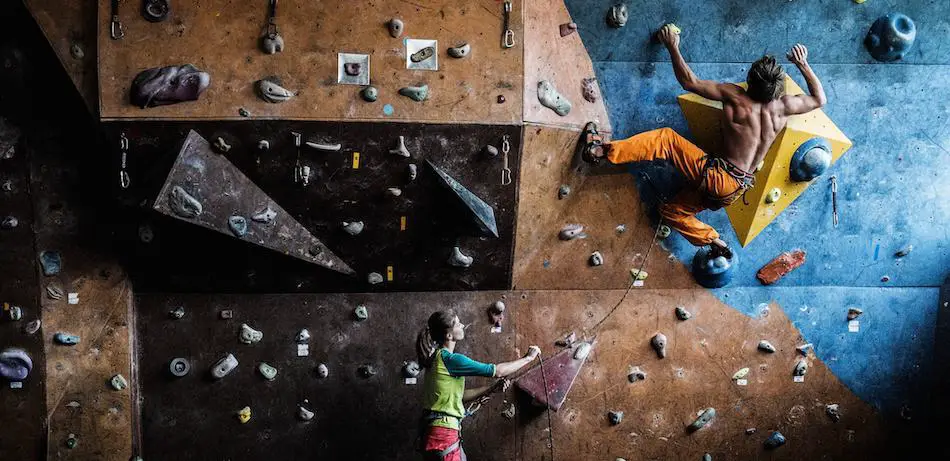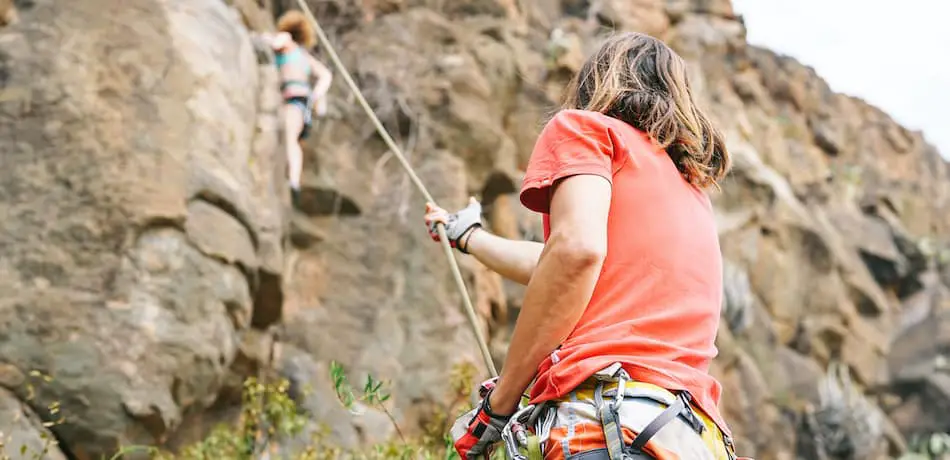
Knowing the difference between top roping and lead climbing is an important distinction. I’ve written the following guide to help you keep the two straight!
So, what’s the difference between top roping and lead climbing? Top roping you’re supported from above, while lead climbing you’re always above your rope. This makes lead climbing both more dangerous and more difficult.
The real distinction between top roping and lead climbing is the belay system used. For top roping, the rope is secured to an anchor above your head (hence the word ‘top’, because the rope is at the top of the route). For lead climbing you bring the rope up with you, clipping into pieces of protection as you go; you ‘lead’ the rope up the wall. When lead climbing, you can’t always rest of your rope, which makes it more dangerous — but also more rewarding.
Top Roping

First, I wanted to give a brief overview of what each type of climbing is. Top roping, like I said, is when the rope that you’re tied into is anchored at the top of the route and then runs down in two strands: one for you and one for your belayer.
This means that it’s easy for your belayer to take out slack and always be there to catch you. You’re never going to fall very far while top roping. This can make it a lot easier to project certain sections of the route, because you’re able to position yourself much easier on the wall.
Most people will probably learn top-roping when they start climbing. It’s easier, safer, and a lot less scary than lead climbing is, so it’s likely that it will be your intro into the sport. Top roping is a great place to learn the motions and technique of rock climbing.
Lead Climbing

Once they’re comfortable top roping, lots of climbers choose to upgrade to lead climbing. Lead climbing is when you tie into the rope at the bottom of the route, so it’s not anchored to anything.
You then climb up the wall, trailing the rope behind you and clipping it in at certain points so that it catches you when you fall.
Lead climbing is a lot more difficult than top roping is, for a variety of factors:
- Fear: Falls are a lot bigger and scarier on lead, which can hold some people back when climbing.
- Fall distance: When you fall lead climbing, you go a lot farther than you do when top roping. This makes it harder to repeat difficult sections of a climb.
- No help from the belayer: On top rope, your belayer can help you through certain sections by weighting their end of the rope, which will pull the climber up the wall. You don’t have this option while lead climbing
However, despite this, lead climbing is also more fun (to me, at least), and more widely useable.
Similarities
Really, the main similarities between lead climbing and top-roping is that they take place on the same route. You’ll be doing the same climbing and the same moves (with a few slight variations).
Because of this, top roping is a great way to figure out difficult projects and practice certain sequences before you try a route on lead. Just about everyone, including professional climbers, does it this way.
Differences

That being said, though, there are quite a few differences between the two that you should be aware of before you start lead climbing. These differences include:
- Risk level
- Difficulty
- Applicability
- Belay Technique
- Recognition
Risk Level
Like I’ve hinted at in this article, lead climbing is a lot riskier than top roping is. When you fall on top rope, you’re caught immediately, and it’s very unlikely that anything bad happens. When you fall on lead, though, you can fall anywhere from five to thirty feet.
This leaves a lot of room for injuries to happen. Some common ones include:
- Pendulums: This is when you swing back into the wall after falling. Pendulums can happen really quickly and can really, really hurt.
- Toe tucks: This is when one of your legs gets caught behind the rope during a fall; this will spin you upside-down, which can make a pendulum way worse.
- Whip lash: If you fall far enough, or you’re just not ready when the rope catches you, you may experience whip lash or other shocks.
Because of this, you need progress slowly as you start top roping and make sure that you’re not pushing beyond your limits. You should take several controlled, intentional falls before you take an accidental one. You also need to be way more careful about where you’re placing your feet so you don’t toe tuck.
Difficulty
Like we already talked about, lead climbing is also a lot more difficult than top roping. When you start leading, I would advise knocking 1-2 grades off of your ‘max’ level; if you top rope around 5.11a, you can expect to lead climb around 5.10c.
This will change once you learn more about the new techniques, obviously, but I would keep an eye out for it at the start.
The other thing about lead climbing being harder is that it ends up being far more rewarding, but we’ll talk about this more later.
Applicability
If you only know how to top rope, your climbing options are going to be limited to:
- Indoor gyms
- Outdoor crags when you have someone to set up a route on top rope
- Outdoor crags that are set up on top rope (very rare)
In most places, you need to be able to lead before you can go climbing. When you’re outdoors, you need someone to lead the first route, because there’s no rope in place.
Lead climbing can also prepare you for a much wider variety of sports. When it’s ice climbing, mixed climbing, trad, or even alpinism, knowing how to lead is going to be essential if you want to progress further into mountain sports.
Belay Technique

Another huge difference is the importance of your belayer when you’re leading. Top rope belaying is easy, and with 15 minutes of practice, just about anyone can be taught to do it.
Lead climbing, on the other hand, is a lot harder to get used to, and it requires a much more active roll from your belayer. They need to be way more skilled and be paying way closer attention to make sure that you don’t get injured while lead climbing.
Because of this, I would be way more careful about who I choose to go lead climbing with. You want to make sure you have an experience belayer who will be able to not only catch you, but do so safely; you don’t want the rope too tight so that you pendulum, or too loose so that you hit the ground.
Recognition
Finally, there’s the recognition/achievement aspect of it, which goes back to what I was saying about lead climbing being more rewarding.
Now, rock climbing is an individual sport, and you can choose to measure your achievements in any way that you want to. However, the fact remains that the philosophy in the sport is pretty set in stone: until you lead-climb a route, you haven’t climbed it at all.
Top roping is great, and good for learning/practicing, but leading is where the true recognition is within the rock-climbing world. You can argue whether or not this is proper, but it’s remained true for the past 50 years, and I don’t see it changing any time soon.
Which Should You Learn First?
Finally, we come to the question of which you should learn first. Interesting, I do think there are some advantages to teaching people to lead climb first. I think it can skip right over lots of the fear of falling that comes with transitioning to lead — sort of a ‘forged in fire’ type of philosophy.
However, with that said, I still think that it’s safer to learn on top rope. By doing so, you’ll be able to climb harder faster, have more fun, and hone your skills/technique without needing to worry about risky falls. This is how most gyms/instructors do it, and this is how I think you should do it too.

